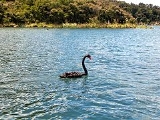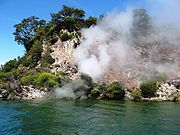
Lake Rotomahana
Encyclopedia

Lake
A lake is a body of relatively still fresh or salt water of considerable size, localized in a basin, that is surrounded by land. Lakes are inland and not part of the ocean and therefore are distinct from lagoons, and are larger and deeper than ponds. Lakes can be contrasted with rivers or streams,...
in northern New Zealand
New Zealand
New Zealand is an island country in the south-western Pacific Ocean comprising two main landmasses and numerous smaller islands. The country is situated some east of Australia across the Tasman Sea, and roughly south of the Pacific island nations of New Caledonia, Fiji, and Tonga...
, located 25 kilometres to the east of Rotorua
Rotorua
Rotorua is a city on the southern shores of the lake of the same name, in the Bay of Plenty region of the North Island of New Zealand. The city is the seat of the Rotorua District, a territorial authority encompassing the city and several other nearby towns...
. It is immediately southwest of the dormant volcano
Volcano
2. Bedrock3. Conduit 4. Base5. Sill6. Dike7. Layers of ash emitted by the volcano8. Flank| 9. Layers of lava emitted by the volcano10. Throat11. Parasitic cone12. Lava flow13. Vent14. Crater15...
Mount Tarawera
Mount Tarawera
Mount Tarawera is the volcano responsible for New Zealand's largest historic eruption. Located 24 kilometres southeast of Rotorua in the North Island, it consists of a series of rhyolitic lava domes that were fissured down the middle by an explosive basaltic eruption in 1886, which killed over...
, and its geography was substantially altered by a major 1886 eruption of Mount Tarawera. Along with the mountain, it lies within the Okataina caldera.
Pink and White Terraces
The Pink and White TerracesPink and White Terraces
The Pink and White Terraces, also called Otukapuarangi or Te Tarata in Māori, were a natural wonder of New Zealand...
were a natural wonder on the shores of the lake before the 1886 eruption. They were considered to be the eighth wonder of the natural world and were New Zealand's most famous tourist attraction during the mid 19th century, but were believed to be buried or destroyed by the eruption.
Scientists rediscovered the lower tiers of the Pink and White Terraces on the lakebed at a depth of 60 metres (196.9 ft) in 2011.

